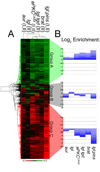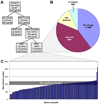Functional genomics identifies neural stem cell sub-type expression profiles and genes regulating neuroblast homeostasis
- PMID: 22061480
- PMCID: PMC4110207
- DOI: 10.1016/j.ydbio.2011.10.020
Functional genomics identifies neural stem cell sub-type expression profiles and genes regulating neuroblast homeostasis
Abstract
The Drosophila larval central brain contains about 10,000 differentiated neurons and 200 scattered neural progenitors (neuroblasts), which can be further subdivided into ~95 type I neuroblasts and eight type II neuroblasts per brain lobe. Only type II neuroblasts generate self-renewing intermediate neural progenitors (INPs), and consequently each contributes more neurons to the brain, including much of the central complex. We characterized six different mutant genotypes that lead to expansion of neuroblast numbers; some preferentially expand type II or type I neuroblasts. Transcriptional profiling of larval brains from these mutant genotypes versus wild-type allowed us to identify small clusters of transcripts enriched in type II or type I neuroblasts, and we validated these clusters by gene expression analysis. Unexpectedly, only a few genes were found to be differentially expressed between type I/II neuroblasts, suggesting that these genes play a large role in establishing the different cell types. We also identified a large group of genes predicted to be expressed in all neuroblasts but not in neurons. We performed a neuroblast-specific, RNAi-based functional screen and identified 84 genes that are required to maintain proper neuroblast numbers; all have conserved mammalian orthologs. These genes are excellent candidates for regulating neural progenitor self-renewal in Drosophila and mammals.
Copyright © 2011 Elsevier Inc. All rights reserved.
Figures






Similar articles
-
Drosophila type II neuroblast lineages keep Prospero levels low to generate large clones that contribute to the adult brain central complex.Neural Dev. 2010 Oct 1;5:26. doi: 10.1186/1749-8104-5-26. Neural Dev. 2010. PMID: 20920301 Free PMC article.
-
Trithorax maintains the functional heterogeneity of neural stem cells through the transcription factor buttonhead.Elife. 2014 Oct 6;3:e03502. doi: 10.7554/eLife.03502. Elife. 2014. PMID: 25285447 Free PMC article.
-
Drosophila medulla neuroblast termination via apoptosis, differentiation, and gliogenic switch is scheduled by the depletion of the neuroepithelial stem cell pool.Elife. 2024 Jun 21;13:e96876. doi: 10.7554/eLife.96876. Elife. 2024. PMID: 38905123 Free PMC article.
-
Regulation of Neural Stem Cell Competency and Commitment during Indirect Neurogenesis.Int J Mol Sci. 2021 Nov 28;22(23):12871. doi: 10.3390/ijms222312871. Int J Mol Sci. 2021. PMID: 34884676 Free PMC article. Review.
-
Control of neural stem cell self-renewal and differentiation in Drosophila.Cell Tissue Res. 2015 Jan;359(1):33-45. doi: 10.1007/s00441-014-1914-9. Epub 2014 Jun 6. Cell Tissue Res. 2015. PMID: 24902665 Review.
Cited by
-
Drosophila nucleostemin 3 is required to maintain larval neuroblast proliferation.Dev Biol. 2018 Aug 1;440(1):1-12. doi: 10.1016/j.ydbio.2018.04.014. Epub 2018 Apr 19. Dev Biol. 2018. PMID: 29679561 Free PMC article.
-
Developmentally regulated subnuclear genome reorganization restricts neural progenitor competence in Drosophila.Cell. 2013 Jan 17;152(1-2):97-108. doi: 10.1016/j.cell.2012.11.049. Cell. 2013. PMID: 23332748 Free PMC article.
-
The Drosophila Sp8 transcription factor Buttonhead prevents premature differentiation of intermediate neural progenitors.Elife. 2014 Oct 6;3:e03596. doi: 10.7554/eLife.03596. Elife. 2014. PMID: 25285448 Free PMC article.
-
DigiTAG-a RNA Sequencing Approach to Analyze Transcriptomes of Rare Cell Populations in Drosophila melanogaster.Bio Protoc. 2020 Nov 5;10(21):e3809. doi: 10.21769/BioProtoc.3809. eCollection 2020 Nov 5. Bio Protoc. 2020. PMID: 33659463 Free PMC article.
-
Neurophysiological defects and neuronal gene deregulation in Drosophila mir-124 mutants.PLoS Genet. 2012 Feb;8(2):e1002515. doi: 10.1371/journal.pgen.1002515. Epub 2012 Feb 9. PLoS Genet. 2012. PMID: 22347817 Free PMC article.
References
-
- Albertson R, Chabu C, Sheehan A, Doe CQ. Scribble protein domain mapping reveals a multistep localization mechanism and domains necessary for establishing cortical polarity. J Cell Sci. 2004;117:6061–6070. - PubMed
-
- Almeida MS, Bray SJ. Regulation of post-embryonic neuroblasts by Drosophila Grainyhead. Mech Dev. 2005;122:1282–1293. - PubMed
-
- Ashraf SI, Ganguly A, Roote J, Ip YT. Worniu, a Snail family zinc-finger protein, is required for brain development in Drosophila. Dev Dyn. 2004;231:379–386. - PubMed
Publication types
MeSH terms
Grants and funding
LinkOut - more resources
Full Text Sources
Molecular Biology Databases

